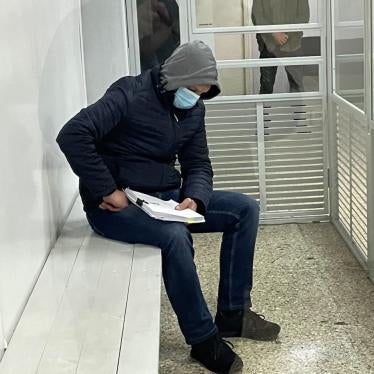The shelling of a school, a kindergarten, and residential areas along the line of contact in eastern Ukraine on February 17, 2022, apparently by Russia-backed armed groups, injured civilians and damaged civilian infrastructure, Human Rights Watch said today. The attacks, which injured at least four civilians, severely damaged or destroyed several homes.
Attacks that indiscriminately strike civilian objects violate international humanitarian law, or the laws of war, and if committed willfully amount to war crimes.
“The recent shelling of schools and homes in Donbas shows just how exposed civilians are to attack,” said Hugh Williamson, Europe and Central Asia director at Human Rights Watch. “Indiscriminate attacks on civilians, who have suffered a heavy toll over the past eight years, need to stop.”
Fighting has escalated in Ukraine’s eastern region of Donbas amid Russia’s recent, unprecedented military build-up along its border with Ukraine. The Special Monitoring Mission of the Organization for Security and Co-operation in Europe (OSCE) reported a significant increase in ceasefire violations in conflict-affected areas along the line of contact on February 17.
At around 9:04 a.m. on February 17, a munition hit a wall of Fairy Tale kindergarten in government-controlled Stanytsia Luhanska and landed in the recreation room. A second shell hit the playground outside.
Two staff members told Human Rights Watch that at least 20 children, from ages 2 to 5, were in the building at the time. Natalia Yudina, 43, a teaching assistant, said that the youngest group had just finished breakfast in another room. “We don’t have a bomb shelter, so the children and staff all gathered in the entrance hall, where there are no windows,” she said. “After breakfast, some children were going to the recreation room, and others were about to go for a walk. It is an absolute miracle that no children were harmed.”
A maintenance worker, Olexander Slesoryv, 34, said: “I was outside sweeping the yard when I heard the whistling. I yelled to the [assistant teacher], who was also outside and stood next to me: ‘Run!’ The [shell] hit the wall and exploded no more than two meters from us. I ran inside and crouched in the corner. I was in a daze. After the first blast, I lost my hearing completely and did not even hear the second explosion outside.”
Three staff, including Slysoryv, Yudina, and a 55-year-old teacher, were taken to a hospital. All three were diagnosed with concussions and various degrees of hearing loss.
Russia-backed armed groups in the Luhansk region and the Ukrainian government blamed each other for the attack. Several military experts, including the open source media group Bellingcat, said that the spray pattern from the impact crater from the shell in the yard was consistent with the attack coming from the south, the direction of Russia-backed armed groups’ positions.
Another attack on February 17 hit a school building in Vrubivka, Popasna district of Luhanska region, which is also under government control. A staff member of a Ukrainian humanitarian group told Human Rights Watch that the attack took place between 10 and 11 a.m., when children from Grades 1 through 4 were in class. The shell hit the schoolyard. The principal told a Ukrainian media outlet that the children were immediately evacuated to the basement.
Hostilities in eastern Ukraine have damaged or destroyed hundreds of schools since the war began in 2014. Attacks that fail to distinguish civilian objects, such as schools that are not being used for military purposes, and military objectives are indiscriminate and are prohibited under the laws of war. Those responsible for deliberate or reckless attacks on civilian objects can be prosecuted for war crimes.
Another shelling attack on February 17 hit a home in Stanytsia Luhanska’s Kondrashovka settlement. Two neighboring homes were also damaged in the attack. Svetlana, 58, the owner of the house, said that the attack was at around 8:30 p.m. She said that her husband, daughter, and a 7-year-old grandson were at home.
“We first heard an explosion very close to the house and my daughter reacted fast. She grabbed [the grandson] and they ran to the basement. My husband and I [have been ill] and not so quick, so we only had time to get to the bathroom when the shell hit. The [military] officials told us later that it was a 122 mm shell.” Svetlana said that the shell struck their living room, and completely destroyed the roof of the house.
Other locations in government-held areas hit by escalated shelling along the line of contact on February 17 included Marinka, 30 kilometers from nongovernment-controlled Donetsk. A shell fragment injured Valentina Gordeyeva, 65, who was waiting for a bus during the morning near her house in Marinka, based on reports from the humanitarian group Proliska and Vostok SOS, a Ukrainian nongovernmental group.
Gordeyeva was taken to a hospital in Kurakhove, where a chief doctor confirmed to media that she had a shrapnel injury to her left arm and a surface wound to her stomach. A Vostok SOS activist, who visited Gordeva in the hospital, told Human Rights Watch that she was expected to be hospitalized for at least three weeks.
Several Marinka residents said that they heard loud explosions in the morning coming from the direction of Donetsk. “We hear it [the shelling] regularly,” said Olexandra, a local resident. “But this time, it was lot more intense and a lot louder. I counted at least 20 explosions … I just thought, I hope they get the children into a shelter.”
Alina Kosse, the head of youth arts center in Marinka, said that the shelling in Marinka began at 9 a.m. and continued until 2:30 p.m.: “At first it was the artillery, then the snipers. We have not had instances of shell fragments hitting residential areas in a while, at least since 2017.”
Kosse said that at around noon, a bullet hit one of the center’s windows. No children were injured. She said that children in one of Marinka’s two schools as well as children from schools in the neighboring town of Krasnohorivka were taken to bomb shelters or school basements during the shelling.
The OSCE Special Monitoring Mission reported 128 explosions on February 17, as compared with 24 explosions recorded in the region in the previous reporting period. In Luhansk region, the mission recorded 402 ceasefire violations, including 188 explosions. The mission also reported that a member of a Russia-backed armed group had threatened a Special Monitoring Mission patrol in the Luhansk region, in an area not under government control.
The Ukraine government’s Joint Forces Operation in the eastern Donbas region reported 60 incidents of weapons fire along the line of contact on February 17, including 43 artillery attacks. On February 18, the military reported continued multiple ceasefire violations and accused Russia-backed armed groups of firing from residential areas. The head of the self-proclaimed Donetsk People’s Republic announced in a video statement a mass evacuation of women, children, and older people to the Russian Federation due to a continued escalation in hostilities.
The use of explosive weapons in populated areas, often referred to as EWIPA, heightens concerns of unlawful, indiscriminate, and disproportionate attacks. Explosive weapons with wide-area effects are those that have a large destructive radius, are inherently inaccurate, or deliver multiple munitions at the same time. This includes unguided and unobserved large-caliber artillery. Long-term effects of the use of these weapons include damage to civilian buildings and critical infrastructure, interference with services such as health care and education, and displacement of the local population.
“Explosive weapons with wide-area effects, when used in populated areas, are among the gravest threats to civilians in contemporary armed conflict,” Williamson said. “Their use should be avoided where civilians live.”











